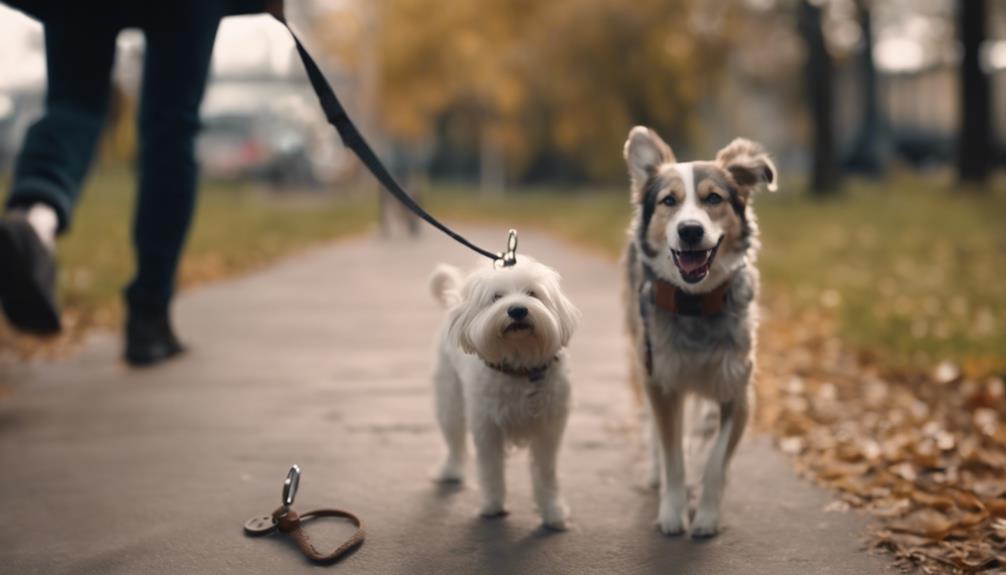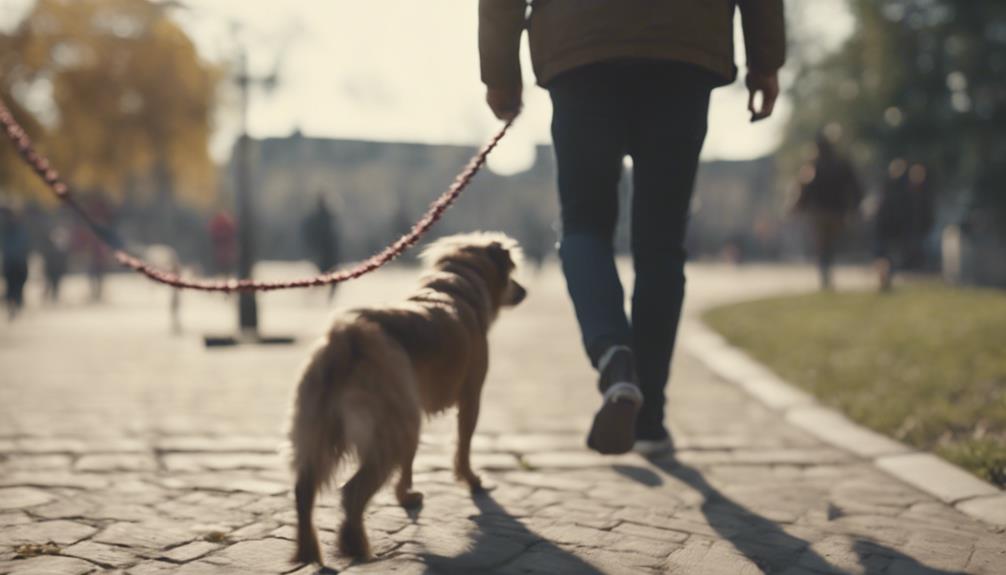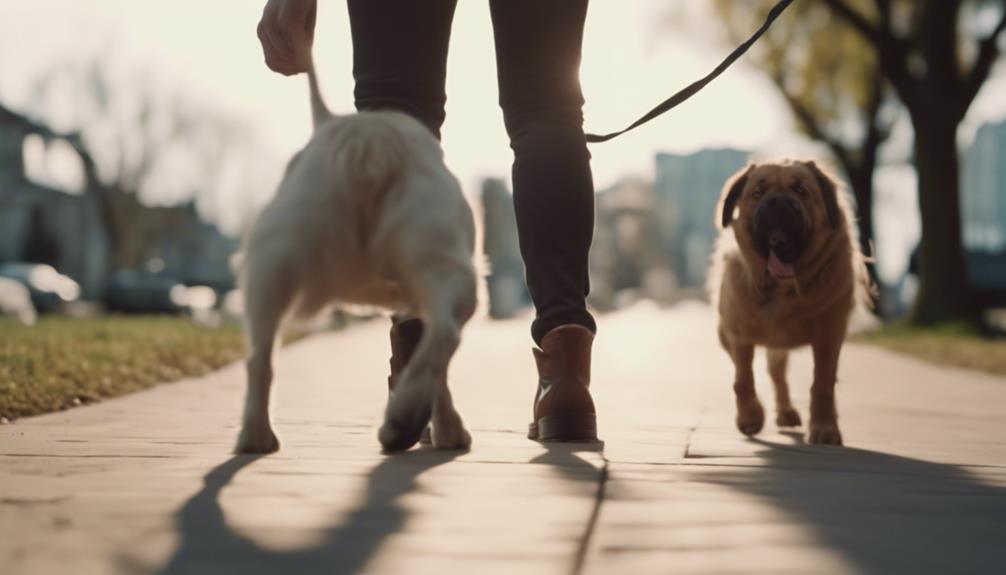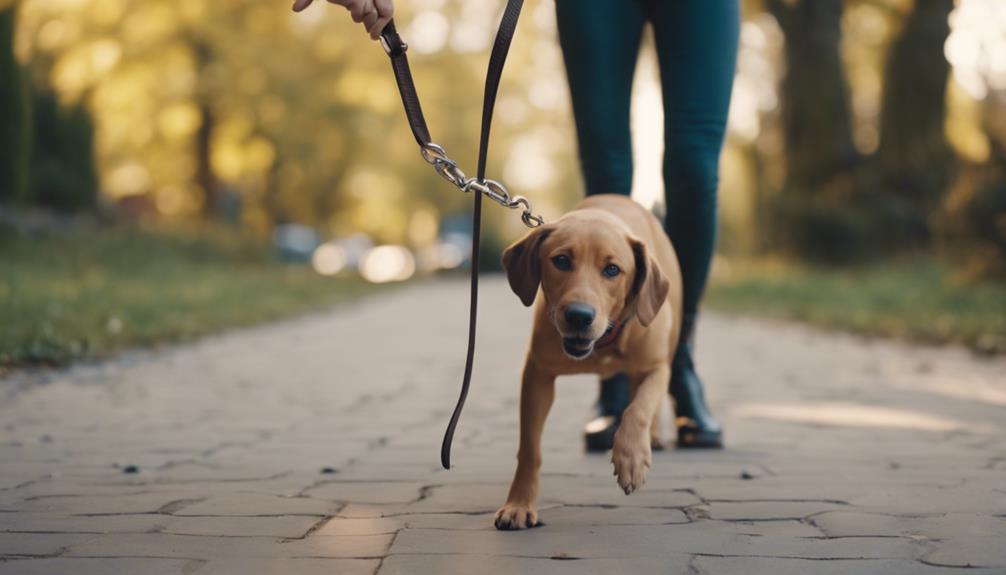Struggling to get your dog to heel on a leash? What if there was a simple yet powerful technique that could make this task a breeze?
Hand targeting holds the key to transforming your walks with your furry friend. By utilizing hand targeting, you can create a seamless communication channel that guides your dog effortlessly into the heel position. This method not only fosters a deeper bond but also paves the way for a more enjoyable walking experience.
But how exactly does hand targeting work, and why is it so effective?
Key Takeaways
- Hand targeting enhances communication and guides your dog effectively in heeling.
- Versatile hand targeting improves responsiveness, leash manners, and overall training experience.
- Positive reinforcement through hand targeting creates a positive association with heeling.
- Consistent reinforcement using hand targeting aids in mastering the heeling position on walks.
Understanding Heeling on Leash
To master leash training, understanding heeling is essential. Heeling means walking right beside you, usually on your left side. This position is crucial in busy or risky environments, ensuring your dog stays close for safety. When crossing streets or navigating crowded areas, heeling is a valuable skill to have. Preparation involves having tasty treats for positive reinforcement and using a clicker or marker.
Teaching your dog a nose-to-hand target is beneficial for leash training, aiding in guiding them into the heel position. By practicing indoors with low distractions and consistently reinforcing heeling behavior during walks, you set the foundation for successful leash training. Remember, patience and rewards are key in teaching your dog to walk obediently by your side.
Importance of Hand Targeting
Utilizing hand targeting is a fundamental aspect of leash training for enhancing communication and guiding your dog's movements effectively. By teaching your dog to touch their nose to your hand, you establish a clear way to communicate desired positions without force.
Hand targeting serves as a non-intrusive method to guide your dog into the heel position, making the learning process easier and more enjoyable. It reinforces the behavior you want without resorting to pushing or pulling your dog.
This technique not only helps in teaching your dog to heel but also provides a versatile tool for various training scenarios. Embracing hand targeting in your training regimen can significantly improve your dog's responsiveness and overall leash manners.
Training Essentials for Heeling

Training your dog to heel effectively requires mastering essential techniques and consistent reinforcement. Start by ensuring you have high-value treats and a marker for signaling good behavior.
Teach your dog a nose-to-hand target, guiding them into the heel position without force. Practice indoors with minimal distractions, clicking and treating for attention. Using hand targeting, lead your dog into the proper walking position.
During walks, maintain the heel with positive reinforcement and patience. Remember to click and treat for successful hand targeting. Stay consistent in your training, gradually increasing the distance between hand targets.
These steps will help your dog understand and enjoy heeling while on a leash.
Benefits of Positive Reinforcement
Positive reinforcement encourages your dog to repeat desired behaviors by rewarding them with treats or praise.
When it comes to teaching your dog to heel while on a leash, positive reinforcement plays a crucial role in the training process. By using treats or verbal praise to reward your dog for walking nicely by your side, you're reinforcing the behavior you want to see more of. This method creates a positive association with heeling, making it more likely that your dog will continue to walk politely next to you.
Additionally, positive reinforcement strengthens the bond between you and your furry companion, making training sessions enjoyable and effective for both of you.
Key Role of Marker or Clicker

The marker or clicker plays a pivotal role in reinforcing specific behaviors during dog training sessions. By providing a distinct sound or signal, it helps your dog understand exactly which actions are being rewarded.
When your dog exhibits the desired behavior, immediately mark it with a click or a verbal marker like 'Yes,' followed by a treat. This clear communication aids in establishing a strong association between the behavior and the reward, accelerating the learning process.
Consistent and timely marking is key to helping your dog comprehend what you're asking for. Introducing the marker or clicker effectively into your training sessions can enhance focus, motivation, and the overall success of teaching your dog to heel while on a leash.
Nose-to-Hand Targeting Technique
Engage your dog by presenting your hand as a target for their nose to touch, creating a connection between your hand and a desired behavior. This nose-to-hand targeting technique is a powerful tool in teaching your dog to heel. By using this method, you can guide your dog into the correct position without force. Here is a breakdown of how to use the nose-to-hand targeting technique effectively:
| Steps | Description |
|---|---|
| Present Your Hand | Extend your hand for your dog to touch with their nose. |
| Click or Mark | Use a clicker or marker signal when the nose touches. |
| Reward | Immediately reward your dog for touching your hand. |
| Repeat | Practice consistently to reinforce the behavior. |
| Transition to Heeling | Gradually transition the nose touch into heeling next to you. |
Practice Without Pushing or Pulling

Practice guiding your dog into the correct position without using physical force. By avoiding pushing or pulling, you encourage your dog to voluntarily move into the desired heel position.
Start by using hand targeting to gently guide your dog next to you. When your dog responds correctly, reward them with a click and treat. This positive reinforcement helps your dog understand the desired behavior without feeling pressured.
Consistent practice without force builds trust and strengthens the bond between you and your dog. Remember, patience and positivity are key in this training process. With time and practice, your dog will learn to heel next to you willingly and without the need for physical coercion.
Click and Treat for Attention
To capture your dog's focus during training sessions, employ the technique of clicking and treating for attention. When your dog looks at you or acknowledges your presence while training, use a clicker to mark that behavior and immediately follow it up with a tasty treat.
This method reinforces the importance of paying attention to you during heeling exercises. By consistently clicking and treating for attention, you're teaching your dog that focusing on you leads to positive outcomes. This conditioning helps build the foundation for successful leash training, as your dog learns that staying connected with you is rewarding.
Remember to be consistent and patient, as this technique will ultimately help improve your dog's attention and responsiveness during heeling.
Walking Indoors With Low Distractions

Begin by selecting a quiet indoor space with minimal interruptions to practice leash training with your dog. This controlled environment will help your dog focus on learning to walk on a leash without distractions. Set up a small area where you can safely practice without the temptation of outdoor stimulations. Use treats and positive reinforcement to encourage your dog to stay by your side as you walk around the designated space.
Leash Training Indoors Table:
| Step | Instructions | Tips |
|---|---|---|
| 1. Equipment Preparation | Gather leash, treats, clicker, and target | Have everything ready before starting. |
| 2. Begin Walking | Encourage dog to walk beside you | Use a calm and encouraging tone. |
| 3. Reward and Repeat | Treat for staying by your side | Be consistent with rewards for good behavior. |
| 4. Practice Turns | Reward for following your direction | Start with easy turns to keep it simple. |
| 5. End Positively | Finish on a good note | End the session while your dog is doing well. |
Guiding Into Heel Position
Use a gentle hand gesture to encourage your dog to move into the heel position. This technique helps your dog understand where to position themselves while walking on a leash. By guiding them gently, you can establish the correct alignment for heeling.
Here are some tips to effectively guide your dog into the heel position:
- Start with your dog on your left side.
- Use a flat hand gesture near your left leg.
- Encourage your dog to move towards the gesture.
- Reward your dog when they align next to you.
- Practice this movement until your dog consistently understands the heel position.
Consistent Reinforcement on Walks

Guiding your dog into the heel position with consistent reinforcement on walks is essential for reinforcing proper behavior. When your dog walks closely by your side, reward this behavior promptly with treats and praise. Be diligent in providing positive feedback each time your dog maintains the desired position.
Consistency is key; ensure that every walk includes opportunities for your dog to practice heeling. By reinforcing the behavior consistently, you help your dog understand what's expected and reinforce the desired action. Remember to use a marker or clicker to signal when your dog is in the correct position, making it clear to your furry friend what behavior is being rewarded.
Versatility of Hand Targeting
The versatility of hand targeting enriches your dog training experience, offering a dynamic tool for effective communication and guidance. Hand targeting can be used in various training scenarios, enhancing your ability to communicate with your furry companion.
Here are some ways hand targeting can benefit your training sessions:
- Enhances Communication: It allows for clear and precise communication between you and your dog.
- Increases Focus: Hand targeting helps keep your dog focused on you during training.
- Facilitates Positioning: You can easily guide your dog into different positions using hand targeting.
- Builds Confidence: Dogs often feel more confident and secure when they understand what's expected of them.
- Adaptable Tool: Hand targeting can be adapted to suit different training needs and challenges.
Overcoming Training Challenges

When facing challenges in your dog training journey, staying patient and consistent is key to overcoming obstacles and achieving success. Dogs may struggle to maintain attention or resist walking close to you during heeling training.
To address these issues, maintain a positive attitude and use high-value treats to keep your dog engaged. Consistent reinforcement of desired behaviors and clear communication through hand targeting will help your dog understand what's expected.
Remember to gradually increase difficulty levels and practice in different environments to generalize the behavior. Overcoming training challenges requires dedication and understanding your dog's individual needs, so adapt your approach as necessary to ensure successful heeling training.
Techniques for Successful Heeling
To achieve successful heeling with your dog, focus on refining your hand targeting technique for precise guidance. Utilize the following techniques to improve your dog's heeling skills:
- Maintain Consistent Hand Targeting: Use hand targeting to keep your dog in the correct position.
- Reward Heeling Behavior: Consistently reinforce your dog for walking in the heel position.
- Practice in Different Environments: Train in various locations to help your dog generalize the behavior.
- Use Verbal Cues: Incorporate verbal cues to signal when to heel.
- Stay Patient and Persistent: Heeling takes time and practice, so be patient and consistent in your training efforts.
Conclusion
Now that you know the secret to teaching your dog to heel while on a leash – hand targeting – you can transform your walks into a harmonious experience.
By incorporating this technique into your training routine, you can effectively communicate with your furry companion and guide them into the desired heel position with ease.
Remember, patience and consistency are key in mastering the art of heeling with hand targeting as your ally.
Happy walking!




